Obviously not every old building in Center Township is architecturally distinct enough to justify a National Historic Landmark status; nor is every neighborhood sufficiently preserved in its original state to earn a National Park Service historic district recognition. But sometimes a structure deserves a little respect, because it captures the essence of what the neighborhood has going for it in terms of palpable urbanism. Once the bulldozers plow through one building to make way for redevelopment, what’s to stop the owners of the neighboring buildings from doing the same thing? And what if the replacement development not only fails to add to this essence but outwardly detracts from it?
Fluffy diction like “essence†or the overused word “character†rarely contributes to a compelling argument against demolition, since these words depend completely upon empiricist judgments. But now we must confront an old apartment that quite possibly will fall in the next few weeks.
All it needs, I think, is a little bit of context. The building in the photo above sits at the southwest corner of Meridian and Morris Streets, only about 1.5 miles from the heart of downtown. As far as I can recall, it was at least partially occupied as recently as 2010, when I first left Indy for an extended period of time; I believe at least a few lights were still on when I got back to the city last summer.
Most people would be hard-pressed to call this a beautiful building. The near absence of ornamental features suggests that it has never really attracted a high-income tenancy; the differences to apartment buildings in the more patrician Near Northside are manifest. Like many structures intended to house the less affluent, the design here is perfunctory. And at this point, the cracked stucco may very well be in an advanced state of disrepair. I have no doubt that the cost to renovate this structure would exceed its value, and the neighborhood around it (called Sacred Heart or Concord, depending on who you ask) is only at the earliest stages of a comeback after decades of disinvestment.
In other words, it seems there’s hardly any reason to salvage this building. The owner is using brokerage firm Velocity Commercial Real Estate to divest himself of what he probably now sees as an albatross. And, at the January 24 Public Hearing, the Hearing Examiner for the Metropolitan Development Commission (MDC) approved a request to rezone the .39 acre parcel from C-4 to C-3, as well as some variance of the development standards of the Commercial Zoning Ordinance to exempt the parcel from excessively large setbacks. The reason? The goal is to demolish the structure and turn the property into a convenience store/gas station.
And there’s the rub. This shabby gray building is nothing special, but it does have one thing going for it: its fundamental form fits well in a pedestrian-scaled neighborhood. The homes around it are a mix of conditions, from newly refurbished to boarded up.
The lack of a distinctive vernacular impedes Sacred Heart’s chances of earning consideration as a historic district, but the broad array of styles means it has a little to offer a variety of tastes. It sits flush to the sidewalk without a real setback, which makes it quite the rarity on the most suburban and automobile oriented side of town. (Sidewalks are few and far between by the 3000 block south.) The fenestration at the corner also suggests that the building once hosted offices or even a small retail space, making its mixed-use status another anomaly for the near south side. It even claims a handful of parking spaces in the back, partially visible in the left side of the photo below:
This photograph also reveals some critical details about the immediate surroundings. The raggedy greenhouse just to the south of gray stucco building along Meridian Street is also for sale, as indicated by the black, white and yellow sign. Here’s another view:
And, to the west of the featured building along Morris Street, a large vacant lot is also for sale.
In other words, three contiguous parcels have been up on the market. But the best replacement that the buyer for the gray building can devise is a gas station. It’s understandable, to an extent: it’s certainly likely to generate far more income than a dilapidated multi-family housing structure. Gas station developers have deep enough pockets that they are willing to shell out the extra dollars for a prominent corner parcel, because they nearly always ensure a cash bonanza when the facilities are attractive and new. This explains why landowners in Center Township come to the MDC left and right with proposals for new gas stations: even in the most distressed neighborhoods, they’re likely to generate a high Internal Rate of Return.
But the intrinsic desirability of gas stations from a developer’s standpoint correlates perfectly to why they’re bad for the Sacred Heart neighborhood. Just one mile to the south, at Meridian and Raymond Streets, stands another gas station.
Like the one proposed at our gray apartment building, it includes a convenience store. But an even uglier predicament languishes just two blocks south of the gray apartment, at Meridian and Arizona Streets:
This boarded-up property has long hosted a Village Pantry convenience store with a few gas stations, and I wasn’t aware it had closed.  In recent years, it had attracted a serious criminal element, culminating in a homicide of a clerk in 2009.  Apparently it’s re-opening: the vehicles parked outside the boarded-up retail structure are renovating it, and a brief conversation with one of the works revealed that it is likely to become a BP. I’m glad to see a tenant returning to the property, but is it really necessary to host another gas station just two blocks away?
Those aren’t the only ones. Just a half-mile to the east of the Morris/Meridian intersection sit two gas stations at Morris and South East Street.  Google Streetview shows that neither one was in exactly mint condition a few years ago.  And another at Kentucky Avenue and West Street, again less than a mile away as the crow flies. In short, four gas stations are already in operation within a mile radius from Morris and Meridian, with a fifth back on its way.  The omnipresence of gas stations obviously reflects our infatuation with automobiles, but how many can a single area support, especially when a few have clearly seen better days?
I have to dredge up a brief anecdote that substantiates my disregard for gas station redevelopment. Before Hurricane Katrina, Lee Circle, a secondary landmark just outside New Orleans’ CBD, had a tired-looking Shell Station directly fronting the northwest quadrant of the circle. It seemed like a pretty unaesthetic use for what could be an attractive civic space, but this circle has never benefited from the same traffic calming treatment and prominence that Indy’s Soldiers and Sailors Monument enjoys. Shortly after Katrina struck, the Shell Station reopened, in even sorrier condition before. Within the next year, a mostly vacant parcel at the southwest quadrant of Lee Circle developed into a clean, bricks-and-mortar Exxon gas station and convenience store. Again, the presence of a gas station hardly enhances Lee Circle’s capacity to serve as a pedestrian attraction or civic space. Regardless of my disappointment that the City had allowed two gas stations to open along this monument, it took only months for one to cannibalize the other. Here’s what the old Shell Station looked like during the March 2011 Google Streetview. I just confirmed a few days ago from a friend that the blighted condition persists in 2013.
My fear is that, coupled with the incompatibility of a gas station in the walkable Sacred Heart neighborhood, the market forces will put the squeeze on the excess, so that one of these other stations will devolve into the old Shell at New Orleans’ Lee Circle. Obviously this is clearly speculative, but the odds aren’t favorable, especially considering that the station at Meridian and Arizona has already closed recently. I’ve commented on the past in my personal blog, American Dirt, on the extreme challenge that vacant gas stations pose for developers: the presence of underground storage tanks (and the propensity for aging ones to leak and contaminate the ground) puts a huge onus for anyone seeking what otherwise would be a desirable corner parcel. Contemporary gas stations use vastly superior standards for storage, and many are compelled by law to remove their tanks if they close operations. But that does not remove the perception of a property too costly to remediate, so that the most likely future of an abandoned gas station is, at best, refurbishment into a new station.
In summation, the short-term gains for redeveloping this property into a gas station don’t compensate for the long-term potential for negative impacts in a neighborhood that is facing enough challenges already. The neighborhood opposition at the Public Hearing last week was vocal, but their numbers were not great enough nor their arguments sufficiently compelling to persuade the Examiner. The photo below is a reminder of one of the biggest hurdles:
Alas, the Concord Neighborhood Center may survive as a building, but the Community Development Corporation that represented its interests is no more; it folded about a year ago.  A CDC would easily have organized the neighbors into a cohesive opposition, but the agency is no more.  Nonetheless, a few members of Sacred Heart and Babe Denny (the neighborhood to the north of Morris Street) assembled an appeal yesterday afternoon before the MDC, so that the upcoming hearing now faces a clear party of remonstrators. The Sacred Heart and Babe Denny neighborhood associations are trying to consolidate their influence under the larger Stadium Village Business Association, but in the meantime these home and businesses owners are working to refine their arguments. Their appeal last week that a 24-hour convenience store encourages crime and undesirable activities was not enough to sway the Hearing Examiner from approving the gas station, nor was the argument that inadequate size of the parcel precluded good traffic flow for such an intensive land use. The developer sought variances to manage the spatial constraints, and the Hearing Examiner approved them as well.
Now we at Urban Indy have tried to step to the plate as a forum to foster further dialogue about what to do with the building at Meridian and Madison. We respect that it may not be worthy of renovation, but we would like to see greater sensitivity to the long-term implications of building yet another gas station. Perhaps future redevelopment considerations will account for the two adjacent parcels that are also for sale: demolishing both the greenhouse and the gray building would allow ample space for a sizable multifamily housing development, or something else that would enhance the neighborhood’s attractiveness. Or maybe an ambitious renovator can restore this ugly duckling back to something with integrity. We welcome any further observations and recommendations, and anyone who wishes to partner with the remonstrators please contact me directly at dirtamericana@gmail.com; I will put you in touch with the people you need.
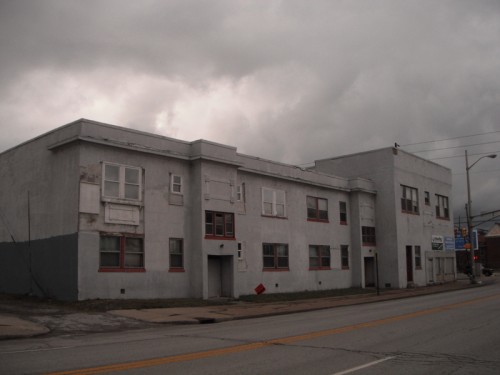
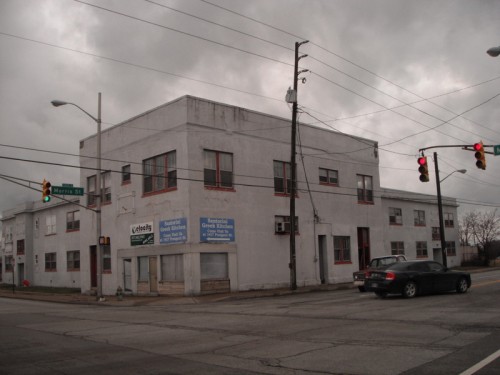

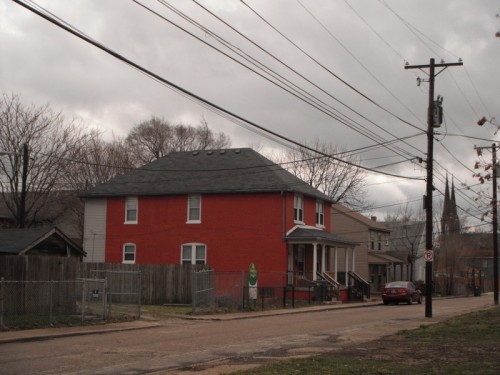
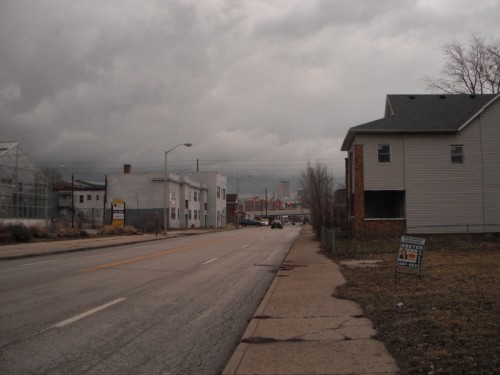
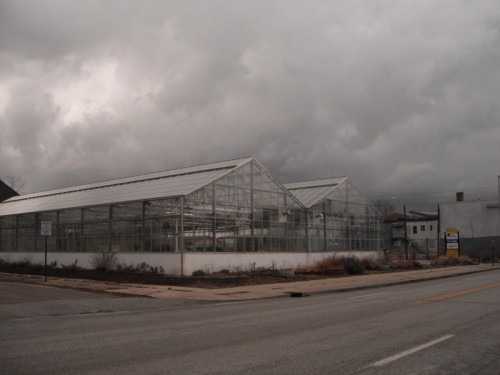
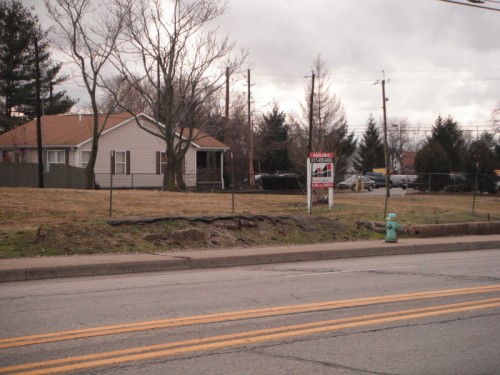
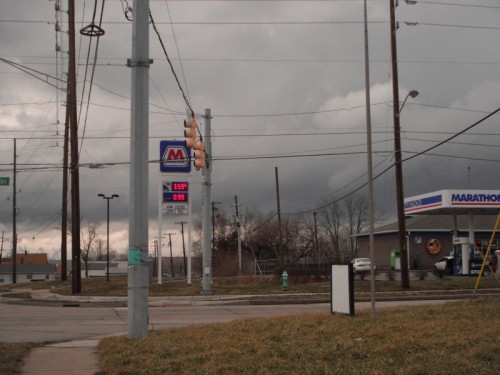

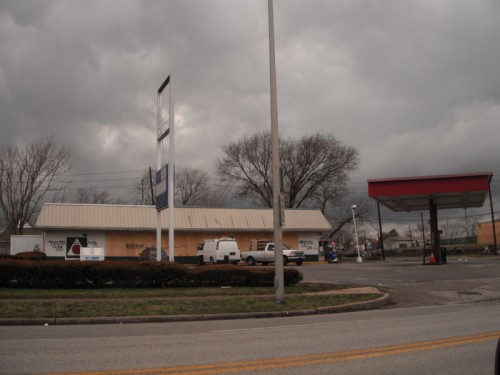

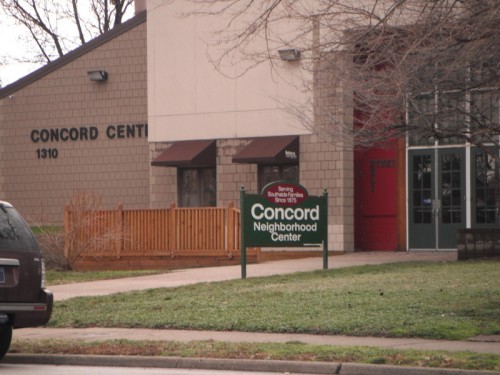
It’s their land. If they want to erect a gas station or a brothel, it’s their business. If anyone wants a say in how someone else uses his land, buy the land from him.
Your absolutist approach to property rights leaves out any accounting of externalized costs (that is, costs pushed off of the property to surrounding parcels). You argue that property rights are sacred, but if you really believe that, then you have to explain why you’d allow this seller’s actions to reduce the value of surrounding properties. A brightly lit, smelly gas station an unappealing neighbor for abutters (would YOU live next to one?), meaning that those owners would have to charge lower rents to compete with more appealing choices (lower rents = less value to the property). Further, by reducing walkability in the neighborhood, a gas station would eat away at the value of properties for blocks around.
Billy, things are not that simple. We have long had zoning and permitting laws (and for many centuries longer we have had the legal concept of nuisance), so nobody can do whatever they please with their land.
All rights have limitations, especially when the exercise of these rights impact the ability of others to enjoy their rights. There is not, nor has there ever been an absolute right of any kind.
That said, when implementing zoning and permitting rules and regulations we must carefully balance societal needs against individuals interests to come up with the fairest and most appropriate solution.
C-3 and C-4 are no longer appropriate zoning classifications for gas stations. They are now intense, 24-hour uses and should require C-5 or higher zoning and very significant buffering from residences.
I worked to purchase these properties and the sellers were absolutely unreasonable. This was the only road they wanted to take.
Thank you for the comments. The sellers will encounter intense opposition if they hope to build a gas station. Obviously, from a certain angle, such opposition is NIMBYism, a stance which Urban Indy contributors routinely criticize. So it does throw into consideration the context by which we view challenges to legally permissible land uses. I encourage others to put forth their recommendations regarding the use for this property. Anybody who travels this stretch of Meridian now and then will be able to see that while the east side of the street is mostly residential or pre-automobile commercial/retail buildings, the west side (far less developed) is largely free reign.
Consider this. That old building, ugly and decayed as it may be, likely brings in more property tax revenue to the city, even if only partially occupied, than the nicest newest gas station ever could. It’s a pernicious and backwards condition of how taxes are calculated, which incentivises decay and replacement of buildings with vacant land or parking lots to reduce assessed valuation. It’s hard to fight such incentives, but it could help to show that such a redevelopment is a loss not only urbanistically but also financially for the city as well.
If we changed how taxes were calculated on property, these sorts of things would remedy themselves quickly based on the financial impact alone.
It appears that the site’s current assessed value is $186,200. For what’s it worth, existing gas stations on small parcels at 1207 S East St (Speedway) & 3802 E Michigan St (Valero) have assessed values of $84,600 & $162,200 respectively.
Interestingly, from what I’ve seen, it appears that canopies and pavement are assessed, but the fuel pumps and underground tanks are not (unless they are included in the canopy assessments).
I agree that our assessment/taxation should be changed to tax the value of land much more heavily than the improvements upon it.
For more comparison, the closed Village Pantry at 1414 S Meridian is assessed at $173,000 and the newer Marathon at 2160 S Meridian is assessed at $370,000.
Chris Barnett is absolutely right. I’m certainly not discouraging anyone from remonstrating against this, but the best way to address this to prevent such future redevelopments is to amend the zoning ordinance. I’ve not seen the plans for this redevelopment, but presumably a gas station could be built on this site without any public hearings, if they would just reduce its size slightly so that they would meet the setback requirements because both the C-3 and C-4 zoning classifications permit gas stations by right.
Yes, it’s a difficult situation for the planner assigned to this specific request, because the highly unrestrictive zoning permits gas stations. It will largely depend on the homeowners and small business owners in the two surrounding neighborhoods (Sacred Heart and Babe Denny) to organize themselves well enough in the absence of a CDC. Since it doesn’t require a rezoning to build gas stations here, only clear public disapproval and a powerful argument will likely prevent the MDC’s approval here. Too bad. As the Rezone Indy initiative lurches forward, this may prove an important consideration for neighborhood revitalization advocates.
Does Indy really look that awful?
Think Spring Grove & Colerain or Norwood in Cincinnati (or another pre-zoning factory/residential mixed neighborhood). Southwest Philadelphia. West End in Columbus, OH. Cicero, IL. Part of every city/metro looks like this.